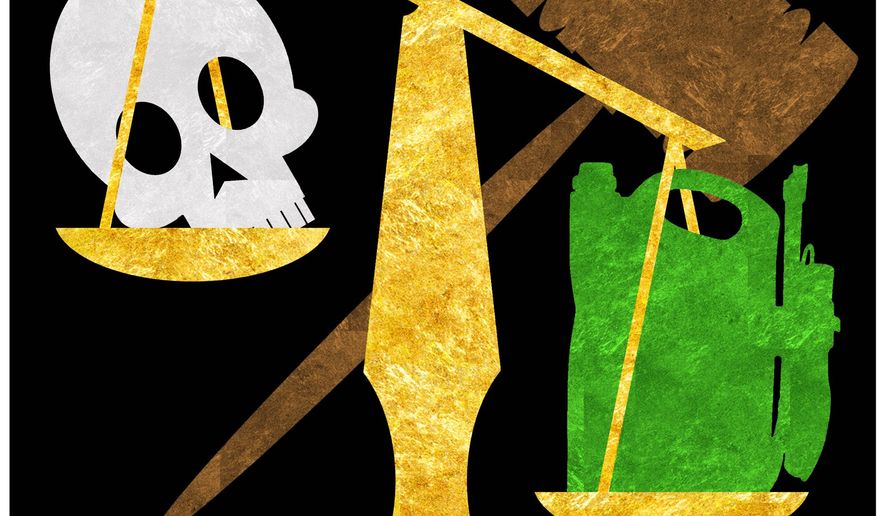OPINION:
It’s good news for consumers that a superior court judge may put the brakes on a case alleging that the popular weed killer Roundup causes cancer. The science behind this claim — and nearly 9,000 other similar cases pending against Roundup’s manufacturer, Monsanto — is sorely lacking.
If this case and others succeed, Roundup will likely be removed from the marketplace based on junk science claims about its risks. As a result, it would be more difficult for farmers to produce an affordable food supply for the rest of us, and consumers will have a harder time controlling weeds in their own gardens.
The case involved a former groundskeeper, whose claimed that glyphosate, the active ingredient in Roundup, caused his non-Hodgkins lymphoma. The jury awarded $39 million for compensation and $250 million a punitive award because Monsanto did not provide warning that the chemical might cause cancer.
In response to a Monsanto appeal, San Francisco Superior Court Judge Suzanne Bolanos indicated that she will likely throw out the entire $250 million in punitive award and call for a new trial. According to CNN, Judge Bolanos explained that the plaintiff “presented no clear and convincing evidence of malice or oppression to support an award of punitive damages.”
The judge’s preliminary decision makes sense because the whole case against glyphosate largely rests on a single, faulty classification of glyphosate as “probably carcinogenic,” which the U.N. International Agency for Research on Cancer (IARC) issued in 2015.
The IARC classification is contradicted by an overwhelming body of evidence that led numerous scientific reviews around the world to conclude that the chemical is not likely to be carcinogenic. These include evaluations by U.S. Environmental Protection Agency (2017 draft risk assessment), the European Food Safety Authority (2015), and the U.N. Food and Agriculture Organization (2016).
IARC’s classification is out of line with others because of a flawed process. Its classifications are the product of ad hoc working groups whose members work behind closed doors and without any binding scientific guidelines. The working groups are free to focus on myriad small-scale studies with implausible results. That can lead to cherry-picking that serves the biases of working group members. In fact, bias is a huge problem at IARC.
Working group members are selected from the “most knowledgeable” (i.e., most published) researchers on a given topic. And because scientific journals favor publication of interesting findings — such as those that report significant associations between chemicals and cancers — working group members often have a stake in validating such associations. Hence, IARC classifications are often little more than the working group members’ self-fulfilling prophesies.
Another problem is that IARC working groups don’t bother to conduct risk assessments. Rather, they simply denote if a chemical or activity poses a “hazard” — notwithstanding the fact that everything in life poses a hazard — i.e., the possibility that it might pose a risk at some exposure level and under some circumstance. Water is a perfect example of such a hazard. If you drink too much at one time, you can die from brain swelling; if it freezes, you can slip and fall on it; if you can’t swim, you can drown in it.
The key to understanding actual risk is to consider dose and real-life exposures, but the International Agency for Research on Cancer does not take those next logical steps.
IARC’s hazard-focused approach makes its classifications nonsensical, like placing smoking tobacco and plutonium in the same carcinogenic category as wood dust, painting houses, salty fish (Chinese style), and processed meat.
Yet you can’t even begin to compare the theoretical risks associated with eating bologna sandwiches and the actual risks associated with smoking cigarettes, as the latter produces nearly half a million fatalities annually in the United States alone.
Ideology and conflicts of interest are a serious problem at the International Agency for Research on Cancer. For example, IARC enlisted an Environmental Defense Fund (EDF) activist, Christopher Portier, as a working group “adviser” on glyphosate. In addition to using the classification to advance his anti-chemical ideology, Mr. Portier has collected tens of thousands of dollars from the trial lawyers as an “expert” witness.
No one should take IARC classifications seriously, let alone use it to as a basis for massive legal awards. Fortunately, it appears that Judge Bolanos agrees, so we may see the pendulum swing back to a more reasonable, science-based position, at least in this case.
• Angela Logomasini is a senior fellow at the Competitive Enterprise Institute and author of the recently released paper “U.S. Should Stop Funding the International Agency for Research on Cancer.”




Please read our comment policy before commenting.